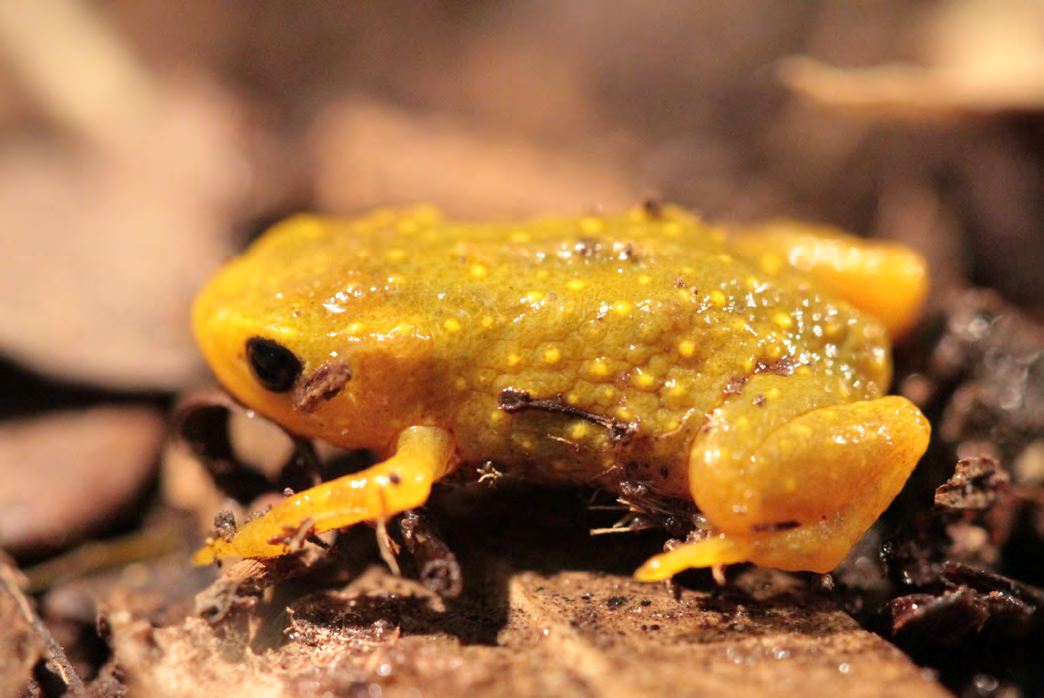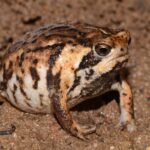- Introduction: Meeting Brachycephalus nodoterga, Brazil's Forest Jewel
- Taxonomy and Classification of Brachycephalus nodoterga
- Natural Habitat: Life Amid the Misty Atlantic Forest's Mountains
- Physical Characteristics: A Portrait of Miniature Elegance
- Behavior and Life Cycle: A Curious and Cryptic Existence
- Ecological Role: A Sentinel of Forest Health
- Threats and Conservation Status: Protecting a Tiny Treasure
- Cultural and Scientific Significance: Small Frog, Big Impact
- Conclusion: Appreciating and Protecting the World's Miniature Wonders
Introduction: Meeting Brachycephalus nodoterga, Brazil’s Forest Jewel#
Amid the enchanting, mist-covered Atlantic Forest of southeast Brazil hides a tiny creature barely larger than your fingertip—a vibrant gem cloaked in rich hues of yellow and orange, with peculiar ridges adorning its delicate back. Meet Brachycephalus nodoterga, a unique species of miniature frog whose discovery has intrigued biologists and nature lovers alike since it was first described in 2015.
With a scientific name illustrating its truly miniature stature—Brachycephalus meaning “short head” and “nodoterga” essentially translating to “ridged back”—this diminutive amphibian occupies a captivating niche in its lush rainforest home. Its exceptional adaptation to its environment, cryptic habits, and striking coloration all make it stand apart even amidst Brazil’s dazzling biodiversity.
Taxonomy and Classification of Brachycephalus nodoterga#
Brachycephalus nodoterga belongs to the family Brachycephalidae, a remarkable, highly specialized group of miniature frogs native to Brazil. Currently, this family consists of only two genera: Brachycephalus and Ischnocnema. This species itself resides firmly within the genus Brachycephalus, a diverse cluster known famously for their dwarf size and vibrant colors.
Discovered and formally described by biologists in recent years, Brachycephalus nodoterga drew considerable attention for its distinct morphological features. Related species within the genus include well-known cousins like Brachycephalus ephippium and Brachycephalus pitanga, each species remarkably unique, adapted specifically to their localized microhabitats.
Natural Habitat: Life Amid the Misty Atlantic Forest’s Mountains#
Brachycephalus nodoterga makes its home exclusively in the Atlantic Forest biome of Brazil, particularly in the mountainous regions near Serra do Brigadeiro in Minas Gerais state. The species thrives in cloud-forested mountainous regions, generally between 1,200 and 1,600 meters above sea level, regions shrouded in mist, scattered with bromeliads, dense moss carpets, and an abundance of leaf litter.
This specialized habitat choice isn’t arbitrary: dense leaf litter and humid conditions provide the ideal microclimate for these frogs, who rely heavily on consistent moisture and specific temperature ranges. Humidity ensures the frogs’ delicate skin remains moist, aiding in respiration that largely happens through the skin itself. This hidden, pristine niche is crucial, as any alteration poses significant threats to their survival.
Physical Characteristics: A Portrait of Miniature Elegance#
Blink and you might miss this humble marvel. Measuring just around one centimeter in length—about the size of a pea—these frogs exemplify miniature elegance. Each specimen sports bright shades of yellowish-orange to reddish-brown, colors vivid enough to rival tropical blossoms tucked beneath towering forest canopies. Their remarkably small size, combined with a somewhat rotund, robust form, grants these frogs their distinctive charm.
Most notably, Brachycephalus nodoterga possesses uniquely developed dorsal ridges—raised, bumpy structures along their back—that inspired their scientific naming. Unlike other related frogs boasting smoother skin textures, these ridges provide a hauntingly beautiful yet subtly fierce form of cryptic self-defense, making them difficult targets for unsuspecting predators.
Behavior and Life Cycle: A Curious and Cryptic Existence#
Life in miniature poses distinctive challenges, shaping many curious behaviors of Brachycephalus nodoterga. Primarily diurnal, these tiny frogs spend their days hidden beneath leaves or between moist moss and are thought to be somewhat territorial, although detailed social behaviors remain relatively unstudied due to their secretive nature.
Their diet is predominantly composed of tiny invertebrates that share their habitat—such as springtails, mites, and minute ants—prey often smaller than the tip of a pin. Through ambush-like hunting tactics, these frogs conserve valuable energy, snapping with incredible speed to consume their prey and immediately retreating into their secluded hideaways.
Reproductive Wonders: Skipping the Tadpole Stage#
One remarkable adaptation of the genus Brachycephalus is their direct development. Unlike most frogs that lay eggs in water where tadpoles develop, nodoterga frogs lay eggs terrestrially, bypassing aquatic stages completely—a necessary adaptation for survival in their moist yet terrestrial highland habitats. Within hidden locations beneath leaves and roots, tiny froglets hatch fully formed, miniature replicas of adults, equipped immediately to live independently.
Ecological Role: A Sentinel of Forest Health#
Though inconspicuous in size, the ecological influence of Brachycephalus nodoterga is immense. Acting as crucial predator and prey within its ecosystem, it regulates the smallest insects and microorganisms, helping maintain the essential balance within the delicate soil community. Moreover, amphibians like B. nodoterga are invaluable indicators of environmental health, their sensitivity to degradation serving as an early warning system signaling disturbances that could cascade through ecosystems.
Threats and Conservation Status: Protecting a Tiny Treasure#
Currently classified by IUCN with limited available data, the conservation status of many new and micro-endemic Brachycephalus species—including nodoterga—remains uncertain, though undeniable threats loom heavily over these tiny inhabitants. Deforestation, habitat fragmentation, climate change, and encroachment by agricultural expansion merge to significantly imperil the delicate microhabitats necessary for the species’ survival.
In response, conservationists and biologists increasingly prioritize the importance of habitat preservation, aiming determinedly to protect Brazil’s unique misty mountainous biomes from further deterioration. Projects aimed at designating protected areas, fostering sustainable agriculture around the Atlantic Forest’s edges, and raising public awareness to safeguard fragile ecosystems are essential to preventing irreversible damage and eventual extinction.
Cultural and Scientific Significance: Small Frog, Big Impact#
Though minute, the discovery and study of Brachycephalus nodoterga illuminate much broader biological, ecological, and environmental insights. Each minuscule frog helps piece together evolutionary puzzles—showing how isolation and specialization can catalyze remarkable diversification. Scientists continually unravel secrets from these frogs’ skin chemicals, adaptations, and reproductive strategies—insights contributing to broader understandings relevant even to human medicine.
Culturally, these frogs symbolize Brazil’s incredible biodiversity heritage, reminding communities of the immense natural richness inhabiting their landscapes, underscoring unique biodiversity as a powerful impetus in conservation education and local engagement.
Conclusion: Appreciating and Protecting the World’s Miniature Wonders#
The story of the tiny Brachycephalus nodoterga exemplifies the incredible wonders often hidden in the most modest forms and the critical importance of their preservation. As guardians and enthusiasts of nature, we possess a unique responsibility—not only to marvel at and understand such beautiful forms of life, but actively contribute to their conservation.
Understanding and appreciating small yet extraordinary creatures like Brachycephalus nodoterga enrich our sense of place within the natural world. It calls us to deeper awareness and action—preserving the damp leaf litter and misty cloud forests for future generations. Discover more about these extraordinary amphibians, spread awareness, and join ongoing conservation efforts—every tiny creature matters, and every habitat counts.








